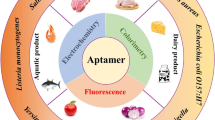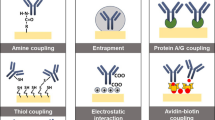Abstract
A rapid detection technology for okadaic acid (OA) in shellfish with one-step immunochromatographic assay using colloidal gold-labeled monoclonal antibody (Mab) probe was developed. OA is one of the diarrhetic shellfish toxins. Firstly, OA was conjugated to bovine serum albumin, and the conjugations as immunogen were injected into mice to raise the polyclonal antibody against OA. Hybridoma cells fused between spleen cells from immunized mouse and myeloma cells (Sp2/0) were prepared and injected into mice intraperitoneally at 1 × 106 cells to produce monoclonal antibody in the ascitic fluid. With the monoclonal antibody against OA, the idc-ELISA assay was established to detect OA. The calibration curve for OA was linear over the concentration range of 0.31–50 ng mL−1, and the detection limit for OA was 0.45 ng mL−1. On that basis, paper test strips for detecting OA were prepared, and a fast detection method for okadaic acid using gold-labeled immunological assay was established. With the paper test strips, the detection limit was 6.25 ng mL−1, and whole detection process for OA in shellfish samples needed only about 40 min.





Similar content being viewed by others
References
Amzil Z, Pouchus YF, Boterff JL, Roussakis C, Verbist JF, Marcaillou-Lebaut C, Masselin P (1992) Short-time cytotoxicity of mussel extracts: a new bioassay for okadaic acid detection. Toxicon 30:1419–1425
Burgess V, Show G (2001) Pectenotoxins—an issue for public health: a review of their comparative toxicology and metabolism. Environ Int 27:275–283
Campàs M, Iglesia PDL, Berre ML, Kane M, Diogène J, Marty JL (2008) Enzymatic recycling-based amperometric immunosensor for the ultrasensitive detection of okadaic acid in shellfish. Biosens Bioelectron 24:716–722
Carmody EP, James KJ, Kelly SS (1996) Dinophysistoxin-2: the predominant diarrhoetic shellfish toxin in Ireland. Toxicon 34:351–359
Dennison N, Anderson DB (2007) The 3 “R”s approach to marine biotoxin testing in the UK. In: Proc. 6th World Congress on Alternatives & Animal Use in the Life Sciences, AATEX 14, Special Issue, Tokyo, Japan, pp 757–761
Dubois M, Demoulin L, Charlier C, Singh G, Godefroy SB, Campbell K, Elliott CT, Delahaut P (2010) Development of ELISAs for detecting domoic acid, okadaic acid, and saxitoxin and their applicability for the detection of marine toxins in samples collected in Belgium. Food Addit Contam 27:859–868
Frens G (1973) Controlled nucleation for the regulation of the particle size in monodisperse gold suspensions. Nature Phys Sci 24:120–122
Garthwaite I (2000) Keeping shellfish safe to eat: a brief review of shellfish toxins, and methods for their detection. Trends Food Sci Tech 11:235–244
Honkanen RE, Mowdy DE, Dickey RW (1996) Detection of DSP toxins, okadaic acid and dinophysistoxin-1 in shellfish by serine/threonine protein phosphatase assay. J AOAC Int 79:1336–1343
James KJ, Bishop AG, Carmody EP, Kelly SS (2000) Detection methods for okadaic acid and analogues. In: Botana LM (ed) Seafood and freshwater toxins: pharmacology physiology and detection. CRC, New York, pp 217–238
Laycock MV, Jellett JF, Easy DJ, Donovan MA (2006) First report of a new rapid assay for diarrhetic shellfish poisoning toxins. Harmful Algae 5:74–78
Liu RY, Chen BJ, Liang YB, Xu DY, Liang B (2008) Preparation and application of the monoclonal antibody against okadaic acid. J Hyg Res 37:443–445 (in Chinese)
Llamas NM, Stewart L, Fodey T, Higgins CW, Velasco MLR, Botana LM, Elliott CT (2007) Development of a novel immunobiosensor method for the rapid detection of okadaic acid contamination in shellfish extracts. Anal Bioanal Chem 389:581–587
Luu HA, Chen DZX, Magoon J, Worms J, Smith J, Holmes CFB (1993) Quantification of diarrhetic shellfish toxins and identification of novel protein phosphatase inhibitors in marine phytoplankton and mussels. Toxicon 31:75–83
Matsuura S, Kita H, Takagaki Y (1994) Specificity of mouse monoclonal anti-okadaic acid and antibodies to okadaic acid and its analogs among diarrhetic shellfish toxins. Biosci Biotech Biochem 58:1471–1475
Mendoza WG, Mead RN, Brand LE, Shea D (2008) Determination of brevetoxin in recent marine sediments. Chemosphere 73:1373–1377
Minoru I, Yukiteru S, Takeharu I, Ikuko IO, Yoshiaki T, Yoshiko N, Akira T (1995) New analysis method for protein phosphatase type 2a inhibitors using the firefly bioluminescence system. Biosci Biotech Biochem 59:2235–2238
Morton SL, Tindall DR (1996) Determination of okadaic acid content of dinoflagellate cells: a comparison of the HPLC-fluorescent method and two monoclonal antibody ELISA test kits. Toxicon 34:947–954
Mouratidou T, Kaniou-Grigoriadou I, Samara C, Kouimtzis T (2006) Detection of the marine toxin okadaic acid in mussels during a diarrhetic shellfish poisoning (DSP) episode in Thermaikos Gulf, Greece, using biological, chemical and immunological methods. Sci Total Environ 366:894–904
Murakami Y, Oshima Y, Yasumoto T (1982) Identification of okadaic acid as a toxic component of a marine dinoflagellate Prorocentrum lima. Bull Jpn Soc Sci Fish 48:69–72
Murata M, Shimatani M, Sugitani H, Oshima Y, Yasumoto T (1982) Isolation and structural elucidation of the causative toxin of diarrhetic shellfish poisoning. Bull Jpn Soc Sci Fish 48:549–552
Núnez PE, Scoging AC (1997) Comparison of a protein phosphatase inhibition assay, HPLC assay and enzyme-linked immunosorbent assay with the mouse bioassay for the detection of diarrhetic shellfish poisoning toxins in European shellfish. Int J Food Microbiol 36:39–48
Quilliam MA (2003) The role of chromatography in the hunt for red tide toxins. J Chromatogr A 1000:527–548
Shestowsky WS, Quilliam MA, Sikorska HM (1992) An idiotypic–anti-idiotypic competitive immunoassay for quantitation of okadaic acid. Toxicon 30:1441–1448
Simon JF, Vemoux JP (1994) Highly sensitive assay of okadaic acid using protein phosphatase and paranitrophenyl phosphate. Nat Toxins 2:293–301
Stewart LD, Elliott CT, Walker AD, Curran RM, Connolly L (2009) Development of a monoclonal antibody binding okadaic acid and dinophysistoxins-1,-2 in proportion to their toxicity equivalence factors. Toxicon 54:491–498
Souto ML, Fernández JJ, Norte M, Fernández ML, Martinez A (2001) Influence of amino acids on okadaic acid production. Toxicon 39:659–664
Tachibana K, Scheuer PJ, Tsukitani Y, Kikuchi H, Engen DV, Clardy J, Gopichand Y, Schmitz FJ (1981) Okadaic acid, a cytotoxic polyether from two marine sponges of genus Halichondira. J Am Chem Soc 103:2469–2471
Usagawa T, Nishimura M, Itoh Y, Uda T, Yasumoto T (1989) Preparation of monoclonal antibodies against okadaic acid prepared from the sponge Halichondria okadai. Toxicon 27:1323–1330
Yang LG, Wei PH, Guo AZ (1998) The enzyme immunoassay. Nanjing University Press, Nanjing, pp 279–281 (in Chinese)
Yasumoto T, Oshima Y, Yamaguchi M (1978) Occurrence of a new type of shellfish poisoning in the Tohoku District. Bull Jpn Soc Sci Fish 44:1249–1255
Zhang WB, Zhang ZJ (2011) The establishment of national food safety standards in the aquatic food shellfish toxins indicators. China Health Stand Manage 2(6):37–41 (in Chinese)
Acknowledgments
This study was supported by the China National Marine 863 Program (2007AA09Z406), the Project for Excellent Academic Leaders (08SD14037), the International Cooperation Project (08540702600), the Biomedical Sciences Project (10391901900), and the Mountaineering Project (06dz12015) from Shanghai Committee for Science and Technology, the Hydrobiological Project of Shanghai Leading Academic Discipline (III) (S30701), China.
Author information
Authors and Affiliations
Corresponding author
Rights and permissions
About this article
Cite this article
Hu, L., Liu, J., Wang, Q. et al. Development of an immunochromatographic strip test for the rapid detection of okadaic acid in shellfish sample. J Appl Phycol 25, 1091–1099 (2013). https://doi.org/10.1007/s10811-012-9949-3
Received:
Revised:
Accepted:
Published:
Issue Date:
DOI: https://doi.org/10.1007/s10811-012-9949-3




